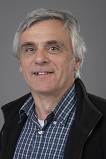Sirotti Fausto
Toutes les versions de cet article : English , français
Electrons Photons Surfaces Group

fausto.sirotti-AT-polytechnique.edu
+33 (0)1 69 33 46 89
I am interested in photoelectron spectroscopy and to his application to dynamic phenomena induced by short laser excitations : phase transitions, surface magnetism, and surface and interface reactivity of materials. I have been using soft X-rays synchrotron radiation for almost thirty years in surface science applications. I am associated to the TEMPO Beamline of SOLEIL and I have collaborations with research groups on synchrotron radiation sources and Free Electron Lasers in France and abroad (Italy, Germany, Switzerland, Japan).
After a Post Doc at ETH- Zurich where I studied surface magnetization dynamics, my activity was dedicated to the installation of a time resolved measurement of spin polarized secondary electrons at LURE Laboratory on the SU7 beamline of the SuperACO synchrotron radiation source. We performed the first experiments following surface magnetization dynamics using the synchrotron radiation time structure.
I joined the CNRS in 1995 (CR1) at LURE Laboratory. In 1996 was leader of the project “High energy, high resolution” for the construction of a new beamline at SuperACO. SB7 fulfilled all expectations in terms of energy resolution and polarization control. It was open to the user community in 1998. In 2000 a new experimental station dedicated to surface spectroscopies was installed on the beamline and opened to the users until the SuperACO shutdown end 2003.
With the construction of SOLEIL Synchrotron, I have been responsible of the construction project of a new beamline dedicated to the studies of electronic structure with time resolved spectroscopies : “Time-resolved Experiments on Materials with Photoelectrons Spectroscopy” (TEMPO). It was the first beamline on insertion device open at SOLEIL in 2007. The time resolution ranges from milliseconds to picoseconds to follow a wide range of phenomena : from surface reactivity to magnetization dynamics. The collaboration with a large scientific community gave over 10 years a large number of applications.


 orcid.org/0000-0001-8753-8425
orcid.org/0000-0001-8753-8425